Social media helps you connect and communicate with people in ways traditional channels can’t match.
But each platform has its own quirks and attracts different types of users, so you need to learn where your audience hangs out.
For example, If your brand is big on visuals, you might see growth on Instagram, while X might be the best fit if your content is mostly short, text-based.
That’s why this article will share important social media stats and show you how to pick the right platforms to make your social media marketing work.
So, let’s get started!
Why choosing the right social media channels matters
Social media is your gateway to billions of users. Because there are about 5.22 billion users, which is 63.8% of the world’s population, on social networks. By sharing engaging content, you can reach all of these people.
But social media does more than boost brand visibility. It’s a powerful tool for building strong relationships with your audience. Social platforms like Facebook, X, and Instagram help you build real connections.
This can be done through DMs, comments, and replies. This kind of personal engagement really matters. Because 64 % of consumers say they want brands to connect with them.
Social media is also the go-to spot for customer service. About half of the people who contact brands on social media have questions or concerns.
Moreover, social media is also great for generating leads—organic posts or paid ads can bring in new prospects. No wonder businesses spent $243 billion on social ads in 2024, which is set to top $406 billion in 2029.
How to select the right social media platforms for your business
Here are some quick tips to get you started:
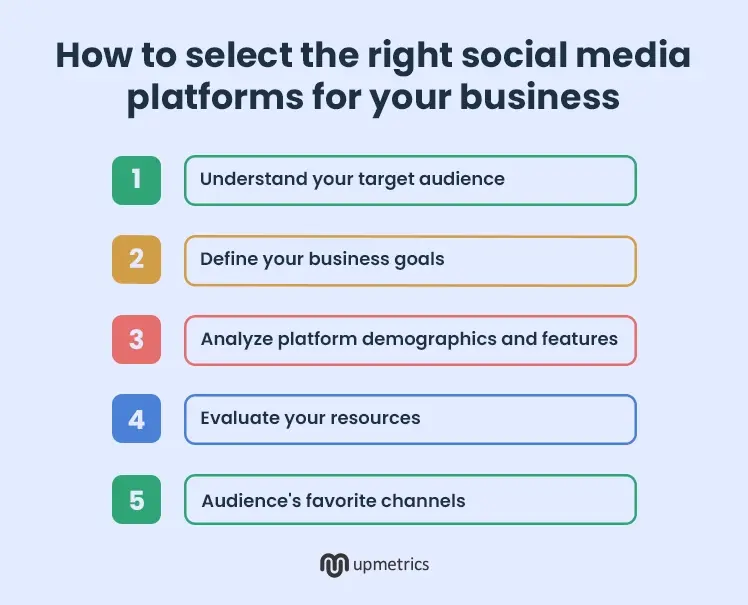
1. Understand your target audience
Social media success starts with truly knowing your audience. Whether you’re planning a social-focused campaign or a broader marketing strategy, start by sketching a clear profile of your ideal customers.
Cover the basics—age, interests, education, income, values and location. You can speak to them in a way that feels personal and real when you understand their fears, challenges, and desires.
Once you have this clarity, shape your business profile to resonate with each potential customer segment. Remember, empathy leads to trust.
When your audience feels understood, they’ll not only engage with your brand but also become loyal followers who actually buy from you.
But what if your target audience has two different groups?
You might be targeting sports-loving teens and part-time entrepreneurs in their 30s at the same time. Obviously, you’ll need to adjust your messaging. This is where creating a marketing persona steps in.
Now, what is a marketing persona?
It’s basically a snapshot of a key audience segment. It helps you craft relevant, high-impact content that speaks directly to a potential buyer.
If you cater to diverse groups, we recommend creating 2–5 personas to cover most of your customer base without losing focus.
You can gather a lot of intel about your audience from Google Analytics (GA). Things like age, gender, location—even the types of devices they use—are right there in your reports.
Once you have the data, build your personas. Upmetric’s buyer persona generator can be a handy tool over here.
All you need is to fill in basic details like shown here:
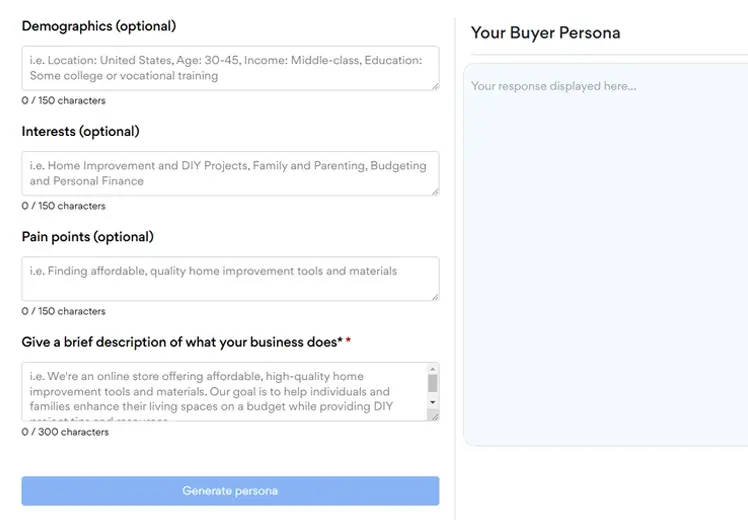
Click on “Generate persona” and within seconds, you’ll get a complete, ready-to-use buyer persona like this:
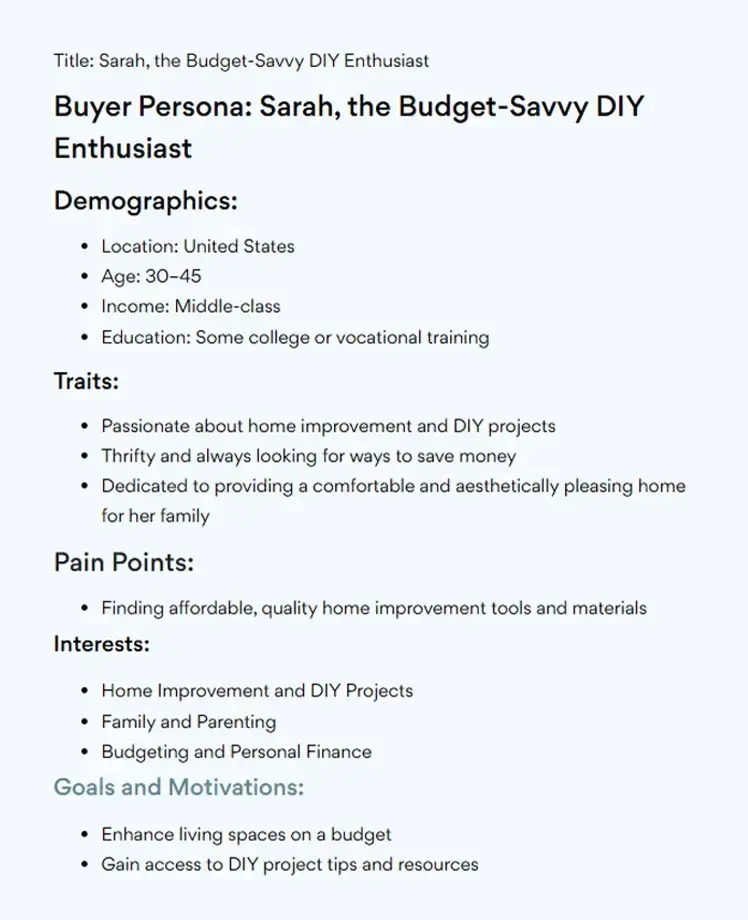
After you create your personas, it’s time to refine the tone and voice for each of your social media channels. Use adjectives to define your brand personality—words like “bold,” “friendly,” or “authoritative.”
Keep in mind that your brand personality drives your voice, but you can still flex your tone depending on who you’re talking to and where. For instance, you might be fun and chatty on TikTok while more professional on LinkedIn.
2. Define your business goals
Social media can deliver huge wins for your business—if you set clear goals and stay updated with advertising trends. Are you trying to generate leads, grow your brand, or connect with your audience in real time? Once you know your objectives, you’ll be able to choose a social media channel.
Think about what matters most to you. For example, do you want to expand reach, drive traffic, or boost SEO?
All of these are possible with social media. You just need to match the right goals with the right platforms. For instance, you can use:
- Instagram or TikTok for visual storytelling.
- X (formerly Twitter) for real-time trends and quick updates.
- YouTube + LinkedIn if your audience is diverse or you need both video and professional content.
Now test different social media post ideas for different platforms and track your progress. If you don’t see results, tweak your approach. Also, try social listening. It can help you understand what your audience is talking about, so you can refine your strategy based on real social media conversations and trends.
With a little testing and consistency, you’ll build a social media presence that supports your objectives and keeps your audience coming back for more.
3. Analyze platform demographics and features
Focus on the platforms your audience actually uses. This will help you to make your social media marketing work. Now, each platform has a unique demographic.
For example, see how social network users vary by age:
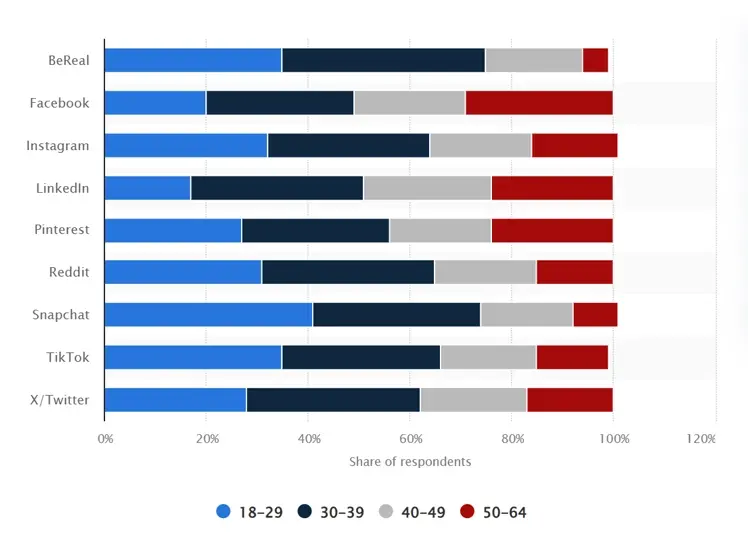
According to this, if you’re targeting an audience between 18 and 29, then choose Instagram and Snapchat.
Similarly, if you’re aiming at professionals aged 30-49, select LinkedIn. It’s where career-minded people connect and share ideas. This makes it ideal for B2B or reaching decision-makers.
Trying to manage too many platforms can get overwhelmingly fast.
If your audience is active on multiple networks, streamline your efforts by:
- Prioritizing platforms: Focus on 1-2 platforms where your audience is most active.
- Using social media tools: These tools can help you schedule posts and manage engagement across multiple networks without the stress.
- Tracking what works: Monitor performance to see which platform delivers the best results and double down on those.
Remember, the goal isn’t to be everywhere. Instead, it’s to be effective. By focusing on the right platforms, you’ll connect with your audience, save time, and get better ROI.
4. Evaluate your resources
Managing social media takes time and effort, so it’s crucial to assess the resources you have before choosing platforms.
Be realistic about the time and people you can dedicate. If resources are tight, it might be better to stick to less demanding channels.
Before branching out to multiple platforms, consider the time commitment and learning curve.
It’s also important to remember that resources go beyond just time and people. The tools you use for content creation and post-scheduling also play a big role, so ensure they’re part of your planning.
5. Check which channel your audience spends most of their time
Understand where your audience actually is by reviewing which social platforms they use.
Each network has its own audience preferences, content styles, and unique features.
Here’s how to check some of the top platforms:
If you’re aiming for a broad audience who falls largely between ages 25 and 34, Facebook’s massive user base (over 3 billion monthly active users) makes it an excellent place to start.
Facebook is perfect for videos. You can showcase products, share how-to tutorials, post updates, or even host live Q&As. Live videos work especially well—they get six times more engagement than regular ones!
It’s also a great platform for building a personal connection. Share behind-the-scenes moments like your team at work or your creative process. People love seeing the human side of your brand.
And If you’re into user-generated content, Facebook is a solid pick. Sharing customer reviews, photos, or stories here not only boosts engagement but also builds trust with your audience.
Instagram has over 1.4 billion users. And most of them—about 85%—are under 45. If your target audience comes into that category, then go for Instagram.
Live videos are a hit. Stories (which disappear after 24 hours) and Reels (short, catchy videos) are perfect for grabbing attention. These formats make it easy to connect with your audience and keep them engaged.
If you’re selling products, Instagram Shopping can provide more benefits. It lets people buy directly in the app without having to visit a separate website.
Your Instagram Shop can feature:
- Themed collections like new arrivals or seasonal picks.
- Product detail pages with pricing, descriptions, and tagged content.
- Product tags in posts and videos to highlight items from your catalog.
- In-app checkout to make purchases quick and easy.
So, if your target audience likes visuals, videos, and shopping, then select Instagram for it.
LinkedIn stands apart as a professional hub with 942 million members, most of whom are 25 to 34.
Content that performs well typically includes:
- Thought leadership pieces
- Career development tips
- Industry insights
These types of posts help you build credibility and attract a professional audience. If you’re in B2B marketing, sharing articles or career updates can be a great way to engage decision-makers.
LinkedIn also works if you’re looking to recruit. It’s the best place to post job openings or give a behind-the-scenes look at your workplace.
YouTube
On YouTube, you’ll find a broad audience (the largest age group is 25-34), making it ideal for various video types.
For longer content, like tutorials and interviews, YouTube keeps viewers engaged. If you’re looking for quick attention, YouTube Shorts are a great way to attract new viewers with short videos.
To expand your reach:
- Regularly collaborate with creators or brands
- Encourage subscriptions and engagement (likes, comments, shares
X (Formerly Twitter)
People turn to X for entertainment, to stay connected with friends and family, and to follow influencers and celebrities.
But when it comes to brands, things shift a bit.
While entertainment is still key, users are also drawn to educational product content, as well as contests and giveaways. If you can provide value through these types of posts, X is a great place to engage your audience.
6. Test and monitor
Once you’ve picked a social media platform or narrowed it down to a couple, test and track its performance.
Every platform has an analytics section where you can check engagement, followers, and shares. These insights can help you figure out which platforms are worth your focus.
For example, you might start by thinking X and LinkedIn are the best options. But after testing both, you could find that X delivers better results.
With that said, let’s check out…
4 common mistakes to avoid when choosing social media channels
To make your marketing efforts successful, it’s important to select the right social media tool. If you don’t pay attention then you might make mistakes that will affect your growth.
Here are some common mistakes businesses make and tips on how to avoid them:
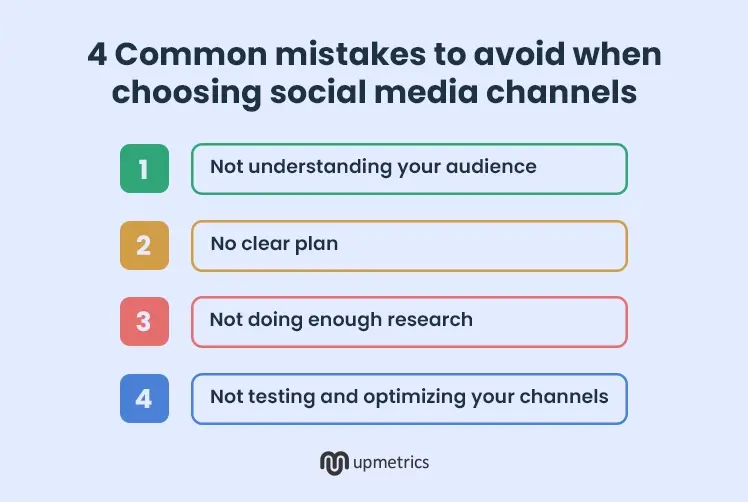
1. Not understanding your audience
One big mistake is not really knowing who your audience is. If you don’t understand their preferences or where they spend their time online, your efforts might not pay off.
To avoid this, research your audience’s age, interests, and behavior. Use analytics tools to see which platforms they use most and update your research as trends shift.
2. No clear plan
Not having clear objectives can make or break a marketing campaign. Ask yourself: What do you want to achieve? Who’s your audience? How will you track progress?
If your goals are not clear, you will pick the wrong channels. Additionally, You might waste time and resources on platforms that don’t fit your needs.
For example, if your goal is to generate leads, focus on channels that support lead magnets, landing pages, or forms.
These will be more effective than platforms geared toward building awareness or encouraging engagement. Having specific objectives ensures you’re using the right tools to hit your targets.
3. Not doing enough research
Each platform comes with its own sets of the good and the bad. And what works on one might not work on another.
If you don’t do the research, you might select channels that are not meant for your campaign.
For example, if you’re introducing a new product, you’ll want to go for platforms that are fresh and have the potential to go viral. Over here you have to avoid platforms that are already overused. A little research can go a long way in picking the right channels for your campaign.
4. Not testing and optimizing your channels
Another common mistake isn’t testing and optimizing your channels. How do you know if your channels are working? How can you measure and improve your results? If you’re not testing, it’s difficult to understand what’s really driving success.
Without this step, you might end up using channels that aren’t effective or even harmful to your campaign.
For example, in a multi-channel campaign, using tools to track and compare performance across different platforms is much better than just guessing what’s working. Testing and optimizing ensures you’re getting the most out of your efforts.
Conclusion
Social media is a great way to reach people all over the world but the main challenge is selecting the right platforms for your business. So, avoid using any platform just because everyone else is doing it.
Instead, find out where your customers spend their time. The six steps shared in the blog will help you make a smart plan and see real results.
But social media is just one part of a bigger picture. If you want to turn your vision into a full business plan, try Upmetrics. Its AI builds your plan in minutes. All you have to do is provide some basic details, and the platform generates a plan in no time.

